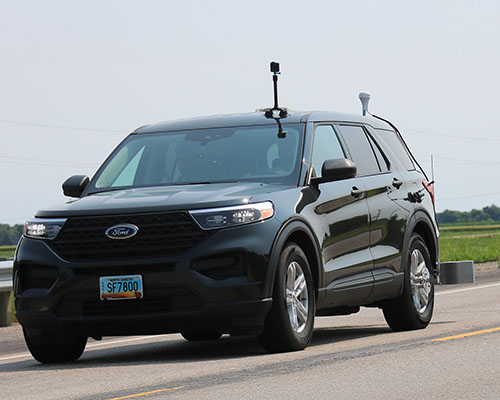Local Input Is Critical to Local Road and Bridge Investment Needs Study
Posted: Jul 31, 2025
 Input from townships and counties across North Dakota is critical to updating local road and bridge investment needs estimates for the next legislative session, according to researchers at the Upper Great Plains Transportation Institute (UGPTI) at NDSU.
Input from townships and counties across North Dakota is critical to updating local road and bridge investment needs estimates for the next legislative session, according to researchers at the Upper Great Plains Transportation Institute (UGPTI) at NDSU.
“Unless our local partners provide information about local improvements and maintenance, we likely won’t know about it,” said Brad Wentz, UGPTI program director. Wentz and his team developed and maintain the Geographic Roadway Information System (GRIT), which provides local units of government an online means of maintaining an inventory of roadway assets with data on characteristics such as base materials, subgrade strength, shoulder type and width, pavement thickness, age, road width, roadway construction details, road condition, bridges, culverts, signs, and numerous other details. GRIT helps local road managers plan how to use their limited budgets to maintain and update their road systems most effectively while NDSU uses the data in its statewide investment needs studies.
Later this fall, UGPTI will distribute a survey to all 53 ND counties and the state’s 1,300 organized townships to gather data on gravel road maintenance. UGPTI researcher Alan Dybing said the information from those surveys helps track gravel costs as well as gravel road maintenance practices such as blading and graveling frequency, dust control, and base stabilization. The surveys also allow counties and townships to provide information on the condition of their gravel roads and to report unique challenges such as flooding or circumstances leading to high levels of traffic.
In the study, the unpaved road analysis assigns maintenance costs based on traffic level forecasts from the traffic model as well as local costs for gravel and maintenance.
UGPTI personnel will also visit a number of counties in the coming months. “It’s our opportunity to gather information on things that can’t be covered in a survey,” Dybing said.
In the previous two biennial studies, researchers added more detail on bridges and “minor structures,” which include culverts and bridges under 20 feet in length. Local input is critical for improving the accuracy of those details. “We used relatively old data to include those structures,” Wentz said. “We count on local staff to verify the location and existence of those structures and to document any changes, maintenance, and improvements.”
UGPTI’s bridge analysis factors in the condition of bridge decks, superstructures, and substructures. UGPTI's bridge needs target considers the structural adequacy and safety, serviceability, and essentiality for public use; it also factors in scour and fracture critical ratings, use of timber materials, and load postings.
In the coming weeks, Dybing will meet with ag processors in the state and the North Dakota Division of Oil and Gas in order to examine how new developments in those fields may impact traffic patterns in the state. Those developments will be factored into UGPTI's traffic model, which evaluates and predicts truck traffic across the state. Dybing said the model focuses on truck traffic because it causes the most wear on local roads and bridges. It uses agricultural- and oil-related data to forecast truck traffic over the next 20 years. Those predictions are compared and adjusted against traffic counts taken across the state by the UGPTI and the North Dakota Department of Transportation. Agricultural predictions are based on the nine most common commodities produced in the state, and information is drawn from elevator shipment data as well as from the National Agricultural Statistics Service satellite imagery and county average yields. For oil production, the model considers drilling, fracking, and production, relying on data from the Oil and Gas Division and the Pipeline Division of the ND Industrial Commission.
The analyses will also include data from traffic surveys across the state, updated condition reports on roadways, and survey results related to the cost of maintaining local roads from all 53 North Dakota counties and more than 900 of the state's 1,300 townships.
Wentz notes that UGPTI students in a vehicle specially equipped with instrumentation called a “road profiler” has been traveling all of the state’s paved county roads, covering the north half of the state last summer and the south half this summer. The profiler compiles information on road roughness while a 360-degree camera documents pavement condition and other data. The information is geo-located and uploaded to GRIT for easy access by local road managers, county commissioners, and UGPTI staff.
This is the seventh biennial local road investment needs study conducted by UGPTI since 2010. The study is conducted at the request of the North Dakota Legislature, which uses the final report to guide the distribution of funding to counties under the provisions of House Bill 1066, commonly known as Operation Prairie Dog.